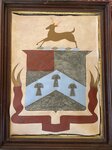

One could assume that Yardley was named after the man who emigrated to America after purchasing the land from William Penn, but the story is not that simple.
William Yardley was an English Quaker, who was persecuted for sharing his beliefs, even to the extent of being imprisoned once. Seeking religious freedom and opportunity across the Atlantic, he purchased 500 acres of land from William Penn for 10 pounds sterling, just 16 days after Penn had acquired the land from King Charles II.
In July 1682, William, his wife Jane, three sons and a servant arrived in America. William was 50 years old. They settled on his land, which was located along what is now Dolington Road just north of present day Yardley Borough.
William was an influential man, described as a “farmer and minister.” He was among seven Quakers who established Fallsington Friends Meeting in May 1683. Aiding in establishing the rules of governance, he intermittently represented Bucks County in the first Colonial Assembly, was a member of the Provincial Council and served as a Justice of the Peace and a Sheriff.
Death soon came to the Yardley family. Wife Jane died in 1691 and William died in 1693.
He did not die of smallpox as has often been written. The smallpox epidemic in 1702 did end William Yardley’s family line. Sons Enoch and Thomas died on the same day — Nov. 23, 1702. All five of their children were dead by January 1703. Son William, who was unmarried, died in December 1702. The wives of Enoch and Thomas survived, but, by law, they could not inherit.
The land reverted to the heirs-in-law in England. To settle the estate, Thomas Yardley, nephew of William, came to America in 1704 with power of attorney for his father Thomas and brother Samuel.
The trip changed the direction of his life. He decided to stay, and he did well. In an article written in 1977, Yardley historian Catherine Belville credited him with being “the creative spirit of early Yardley.”
Solidly planting himself in America, Thomas married Ann Biles in 1706. They had nine children.
Finally in 1710, Thomas and three other appointed Quakers settled the estate of William Yardley. The land was sold to prominent Quaker Joseph Janney for 350 pounds. Nineteen days later, Thomas bought the property back from Janney for the same amount.
Unlike his uncle, there are few references to Thomas Yardley being involved in either the Fallsington Friends Meeting or local government. His business interests dominated.
He was authorized by an act of the Pennsylvania Assembly to operate the ferry across the Delaware River in 1722. The exact location of the landing in Pennsylvania has not been determined, but it was between what is now Letchworth Avenue and East Afton Avenue. The New Jersey landing was in the vicinity of Lower Ferry Road.
A “Ferry House and Tavern” was built to service customers. The left side of the large field stone house north of Letchworth Avenue, today known as “Lanrick Manor” is thought to be the original ferry house.
In 1726, he purchased land, part of which had been owned by John Brock, the original Penn land grantee of the area that is now downtown Yardley. The acquisition included the grist mill and mill pond that Brock and his son had built. Thomas and his descendants expanded the mill structure and the business. The gristmill still stands, and the mill pond is today’s scenic Lake Afton.
Being well established, in 1728 he built a substantial Georgian-style field stone house next to his grist mill and its millpond. Today the mansion, with its stone walls painted yellow, overlooks Lake Afton and is fittingly known as “Lakeside.”
Thomas Yardley shaped the area that was to officially become Yardleyville in 1828. The village name can certainly be attributed to his efforts and influence.
Susan Taylor is the president of the board of directors at the Yardley Historical Association.
“Heralding Our History” is a weekly feature. Each month, the Herald delves into the history of one of its towns.This month we take a look at the historic borough of Yardley.
Join our readers whose generous donations are making it possible for you to read our news coverage. Help keep local journalism alive and our community strong. Donate today.